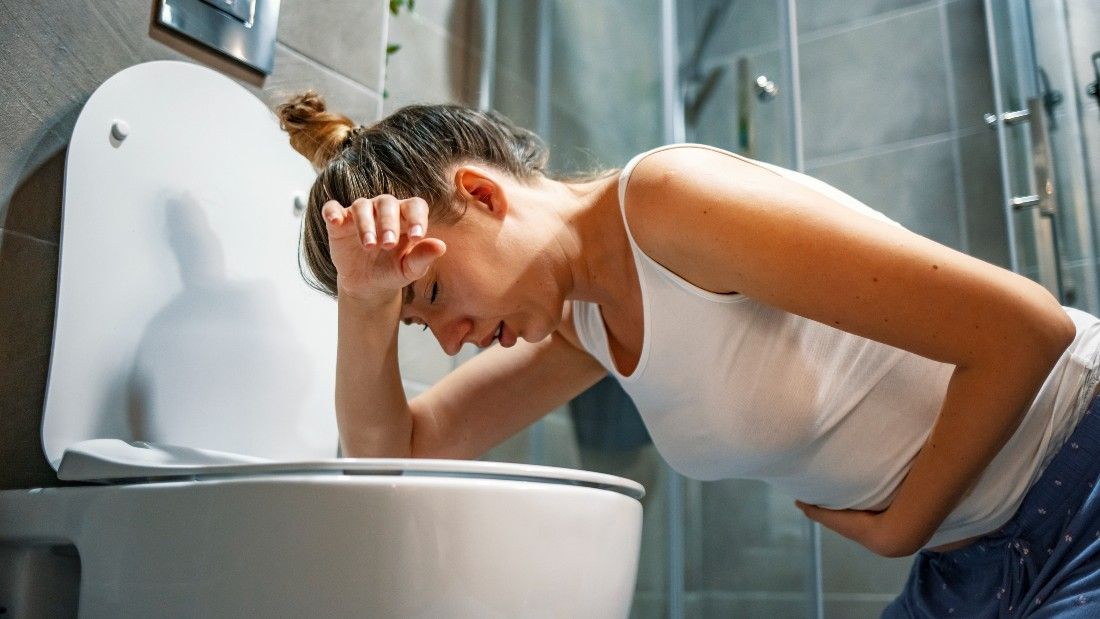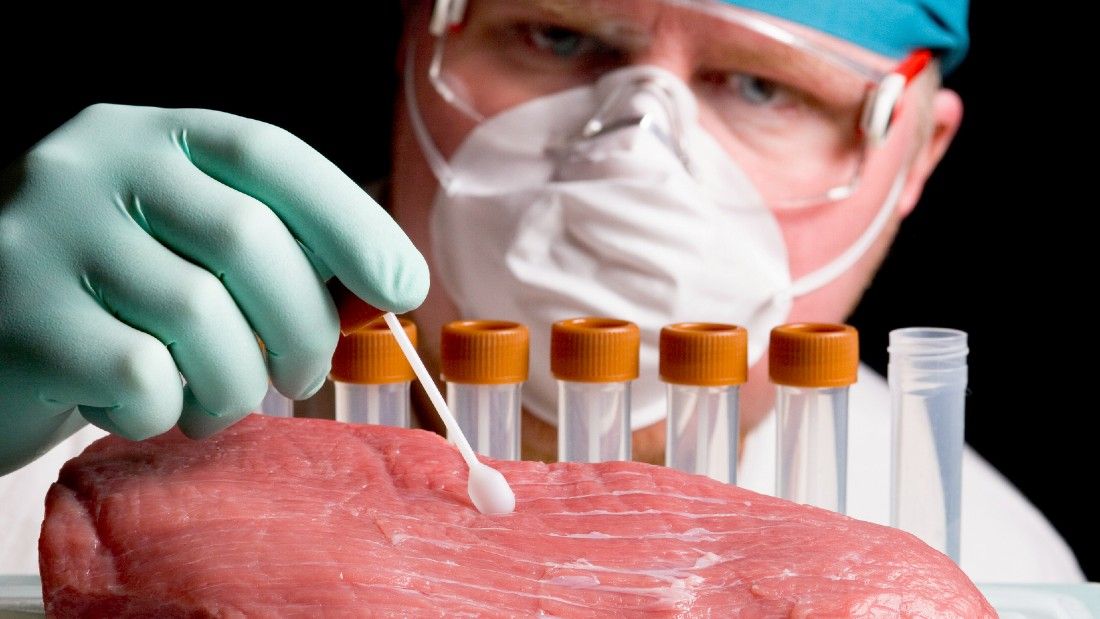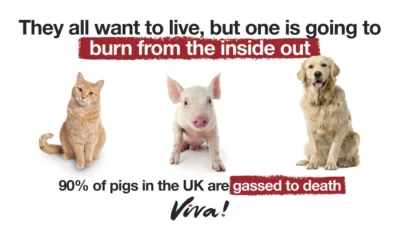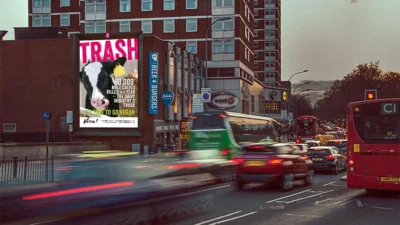Campylobacter – Top of the Food Poisoning Table

Campylobacter is the main cause of food poisoning in the UK and it is estimated that there are more than half a million cases and 80,000 GP consultations every year in the UK.1FSA. 2019. A microbiological survey of campylobacter contamination in fresh whole UK-produced chilled chickens at retail sale (Y2/3/4). Available: https://www.food.gov.uk/research/foodborne-disease/a-microbiological-survey-of-campylobacter-contamination-in-fresh-whole-uk-produced-chilled-chickens-at-retail-sale-y234 [Accessed 3 June 2022]. Specifically, Campylobacter jejuni accounts for around 90 per cent of all Campylobacter infections in humans.2CDC. 2019. Campylobacter (Campylobacteriosis). Available: https://www.cdc.gov/campylobacter/technical.html [Accessed 3 June 2022].
Symptoms include diarrhoea (may be bloody), vomiting, stomach pains, cramps, fever and generally feeling unwell. They usually develop within two to five days after becoming infected but can take as long as 10 days to appear. Illness usually lasts around seven days.
Most people with Campylobacter poisoning will recover fully but it can cause long-term and severe health problems in some. Like other food poisoning bugs, children under five and older people are most at risk because they may have weaker immune systems.
Like E. coli O157:H7, Campylobacter has a low infective dose, that means coming into contact with just a few bacteria can cause illness. This is especially important if you are young or have an underlying illness. You can’t see, smell it or even taste Campylobacter on food but if it affects you, the Food Standards Agency says, you won’t forget it!3FSA. 2018. Campylobacter. Available: https://www.food.gov.uk/safety-hygiene/campylobacter [Accessed 3 June 2022].
Campylobacter bacteria are prevalent in farmed animals such as chickens, pigs, cattle and sheep, and have also been found in shellfish.4WHO. 2020. Campylobacter. Available: https://www.who.int/news-room/fact-sheets/detail/campylobacter [Accessed 3 June 2022]. They are frequently carried in the faeces of chickens, pigs and cattle, but in animals, they don’t normally cause disease. The main route of transmission to people is generally thought to be foodborne, via undercooked meat and meat products, as well as raw or faecal-contaminated milk. Most often, carcasses or meat are contaminated by Campylobacter from faeces during slaughtering.4WHO. 2020. Campylobacter. Available: https://www.who.int/news-room/fact-sheets/detail/campylobacter [Accessed 3 June 2022].
The drive for cheap meat means that animal food processors are constantly striving to develop faster ways of processing carcasses. Mechanical evisceration (removal of internal organs) of poultry can result in the rupturing of their digestive tracts and the spilling of faecal matter onto the skin of the animal.5Cho B, Kim MS, Chao K et al. 2009. Detection of fecal residue on poultry carcasses by laser-induced fluorescence imaging. Journal of Food Science. 74 (3) E154-9. This is obviously a concern with poultry, as some people eat the skin. Companies selling this type of equipment boast how their machines can deal with high processing capacities, now heading towards being able to process 15,000 birds per hour.
Chicken meat is known to be a major source of Campylobacter infection. The first UK government survey of Campylobacter contamination in retail chickens was published in 2015. The 12-month survey, carried out by the Food Standards Agency, looked at the levels of Campylobacter contamination in fresh whole chickens from large retail outlets, small independent shops and butchers. They tested over 1,000 samples and found that 73 per cent tested positive for Campylobacter.6FSA. 2015. Year 1 of a UK-wide survey of campylobacter contamination on fresh chickens at retail (February 2014 to February 2015). Available: https://www.food.gov.uk/other/year-1-of-a-uk-wide-survey-of-campylobacter-contamination-on-fresh-chickens-at-retail-february-2014-to-february-2015 [Accessed 3 June 2022].
A year later they repeated the survey, again testing just over 1,000 samples of fresh whole UK-produced chickens between January and March 2016. They found Campylobacter in 50 per cent of samples. At first this looks like a drop, down from 76 per cent in the same quarter of the previous year. However, one reason these results were lower was because several retailers and their suppliers decided to remove neck skin from chickens before they were sold. The neck skin is the most contaminated part of the chicken and is the part of the bird that the Food Standards Agency had been testing. So, like-for-like comparisons were not possible.7FSA. 2016. Campylobacter contamination in fresh whole chilled UK-produced chickens at retail: January – March 2016. Available: https://www.food.gov.uk/sites/default/files/media/document/campy-survey-report-jan-mar-2016_0.pdf [Accessed 3 June 2022].
In more recent tests, they reported that Campylobacter was found in 54 per cent of fresh, whole retail chicken in the UK, tested from August 2016 to July 2017,1FSA. 2019. A microbiological survey of campylobacter contamination in fresh whole UK-produced chilled chickens at retail sale (Y2/3/4). Available: https://www.food.gov.uk/research/foodborne-disease/a-microbiological-survey-of-campylobacter-contamination-in-fresh-whole-uk-produced-chilled-chickens-at-retail-sale-y234 [Accessed 3 June 2022] 56 per cent of samples taken from August to October 2017 and 75 per cent of samples from smaller retailers tested between August 2017 to July 2018.1FSA. 2019. A microbiological survey of campylobacter contamination in fresh whole UK-produced chilled chickens at retail sale (Y2/3/4). Available: https://www.food.gov.uk/research/foodborne-disease/a-microbiological-survey-of-campylobacter-contamination-in-fresh-whole-uk-produced-chilled-chickens-at-retail-sale-y234 [Accessed 3 June 2022] Campylobacter is not going away!
The Food Standards Agency puts Campylobacter at the top of their priority list as they consider it to be one of the biggest food safety problems affecting people in the UK. They tell people not to wash raw chicken, warning that splashed water droplets can spread Campylobacter bacteria on to human skin, work surfaces, clothing and cooking equipment.

Intensive farming practices increase the risk of zoonotic disease outbreaks. C. jejuni is not just a problem in poultry, it is also carried by 20 per cent of cattle worldwide. An international team of scientists, led by the Universities of Bath and Sheffield, investigated the evolution of this bacterium and found that the overuse of antibiotics, high animal numbers and low genetic diversity has led to the emergence of cattle-specific variants that can infect humans too, triggering a major public health risk.8Mourkas E, Taylor AJ, M¨Ļric G et al. 2020. Agricultural intensification and the evolution of host specialism in the enteric pathogen Campylobacter jejuni. Proceedings of the National Academy of Sciences USA. 117 (20) 11018S\11028.
They found that cattle-specific strains of the bacterium emerged at the same time as the dramatic rise in cattle numbers in the 20th Century. Changes in how cows were farmed provided the opportunity for gene transfer between general and cattle-specific strains helping this pathogen cross the species barrier and infect humans. Combine this with the increased movement of animals through international trade, they say, intensive farming practices are providing the perfect environment for pathogens to spread globally.8Mourkas E, Taylor AJ, M¨Ļric G et al. 2020. Agricultural intensification and the evolution of host specialism in the enteric pathogen Campylobacter jejuni. Proceedings of the National Academy of Sciences USA. 117 (20) 11018S\11028.
Around one in seven people suffer from an infection at some point in their life caused by Campylobacter. It causes three times more cases than E.coli, Salmonella and Listeria combined.8Mourkas E, Taylor AJ, M¨Ļric G et al. 2020. Agricultural intensification and the evolution of host specialism in the enteric pathogen Campylobacter jejuni. Proceedings of the National Academy of Sciences USA. 117 (20) 11018S\11028. Professor Sam Sheppard, from the University of Bath, says: “There are an estimated 1.5 billion cattle on Earth, each producing around 30 kilograms of manure each day. If roughly 20 per cent of these are carrying Campylobacter, that amounts to a huge potential public health risk.”
Sheppard says: “Over the past few decades, there have been several viruses and pathogenic bacteria that have switched species from wild animals to humans: HIV started in monkeys, H5N1 came from birds, now Covid-19 is suspected to have come from bats. I think this is a wake-up call to be more responsible about farming methods, so we can reduce the risk of outbreaks of problematic pathogens in the future.”9University of Sheffield. 2020. Intensive farming increases risk of epidemics, warn scientists. Available: https://www.sheffield.ac.uk/biosciences/news/intensive-farming-increases-risk-epidemics-warn-scientists [Accessed 3 June 2022].
Another emerging problem is the potential for antibiotic-resistant superbugs to spread from livestock to humans. In 2018 the UK Foods Standards Agency reported that ciprofloxacin resistance was found in 54 per cent of C. jejuni samples from retail chicken.10FSA. 2018a. Antimicrobial Resistance in Campylobacter jejuni and Campylobacter coli from Retail Chilled Chicken in the UK. Available: https://www.food.gov.uk/research/antimicrobial-resistance/antimicrobial-resistance-in-campylobacter-jejuni-and-campylobacter-coli-from-retail-chilled-chicken-in-the-uk-0 [Accessed 3 June 2022]. The antibiotic ciprofloxacin is used in humans to treat serious infections, or infections for which other antibiotics have not worked. It belongs to a group of antibiotics called fluoroquinolones which are classified by the World Health Organisation as “critically important in human medicine.”11WHO. 2011. Critically important antimicrobials for human medicine. Available: https://apps.who.int/iris/bitstream/handle/10665/77376/9789241504485_eng.pdf [Accessed 3 June 2022]. The Alliance to Save Our Antibiotics has long campaigned for a total ban on the use of fluoroquinolones in poultry. However, their use is still permitted in UK poultry (and other farmed animals) and Red Tractor standards also allow their use in chickens and turkeys.
In 2017, over 56,000 cases of Campylobacter infections were reported in England and Wales, equivalent to 97 per 100,000 population.12Public Health England. 2017. Campylobacter data 2008 to 2017. Available: https://www.gov.uk/government/publications/campylobacter-infection-annual-data/campylobacter-data-2008-to-2017 [Accessed 3 June 2022]. It’s difficult to find out how many of these were caused by antibiotic-resistant strains and how the infections were transmitted. However, a freedom of information request submitted in 2016 by the Bureau of Investigative Journalism revealed that almost half of all human infections in 2015 with Campylobacter were resistant to ciprofloxacin.13Alliance to Save Our Antibiotics. 2018. Government must ban all use of fluoroquinolone antibiotics in poultry as new FSA survey reveals record levels of resistance. Available: https://www.saveourantibiotics.org/news/press-release/government-must-ban-all-use-of-fluoroquinolone-antibiotics-in-poultry-as-new-fsa-survey-reveals-record-levels-of-resistance/ [Accessed 3 June 2022].
Factory farming provides the perfect conditions for bacteria to adapt and spread from animals to humans, increasing the risk of epidemics. The ever-increasing drive to lower the cost of meat inevitably results in more intensive farming and processing methods. But as we are continually finding out, cheap meat comes at a high cost!




